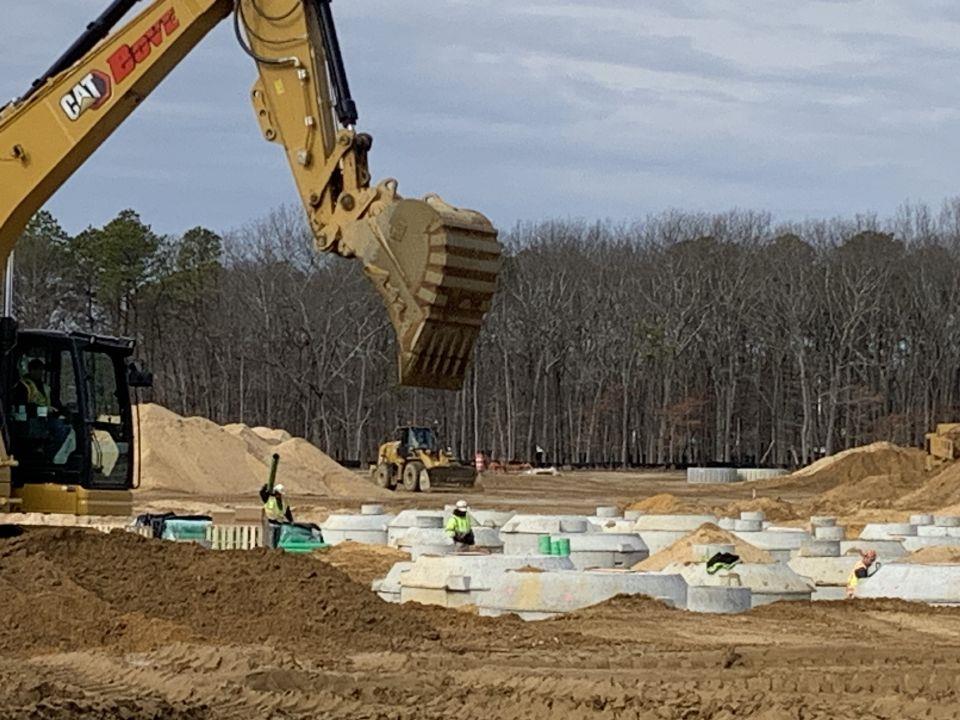The massive effort to bring sewers to the Bay Area after a half-century of delay is coming off without a hitch as the $223.9 million project has seen the installation of collection pipes in Mastic neighborhoods, including feeders under Sunrise Highway, and a treatment plant taking shape near Calabro Airport.
Following an historic groundbreaking in January 2022 attended by hundreds of local officials and residents, the Forge River Watershed Sewer Project has shown significant progress toward its goal of protecting the region’s water quality and stimulate economic growth.
 |
|
Workers install rings for the leeching field at the Advanced Wastewater
Treatment Facility under construction off the North Sunrise Service Road adjacent to Calabro Airport. The facility is designed to treat up to a million gallons of wastewater per day.
|
According to Deputy County Executive Peter Scully, Suffolk’s “Sewer Czar” who’s been a driving force in putting together funding from seven different federal, state and local sources and keeping the effort on track, the project will also include the repaving of all of the local roads disturbed by the construction. “We are installing valve boxes and piping up to the individual homes and businesses and the next step is to have the property owners sign the paperwork allowing access so we can hook them up,” Scully said, noting that the county learned lessons from a similar effort in Babylon and is looking to streamline the process. He said the county will work with Mazzarella’s office to notify residents and set up signing opportunities for the documents which must be notarized. “It’s going to be a lot of work,” the Sewer Czar said in getting the paperwork in order from 1,900-plus residents. The process will start with informational mailings and community meetings planned for the summer.
“With years of promises and the degradation of Forge River, the most polluted water way in Suffolk County, residents stepped up to demand that the sewer project get off the drawing board, and I’m glad they did,” said Assemblyman Joseph DeStefano whose district includes the project area. “Hat’s off to Peter Scully, Legislator Mazzarella and the many officials and residents who worked on this over the years. This will advance environmental protection and economic security for generations to come,” the Assemblyman said with an eye toward securing funding for phases three and four of the project.
 |
|
Work underway as part of the $223.9 million Forge
River Watershed Sewer Project.
|
The state-of-art wastewater treatment plant, about 25 percent complete, will be capable of processing raw sewage at the rate of a million gallons a day keeping cesspool waste out of Forge River and Moriches Bay, two water bodies that have suffered from brown tides due to excess nitrogen coming off the mainland. The region’s once vibrant shellfish hatchery and fishing stocks have been decimated due to pollution and scientists have long advocated for sewers as a key solution to the problem. Combined with sewer projects in three other Suffolk communities, nitrogen pollution in the Great South Bay is projected to be reduced by 25 percent. The county’s 360,000 unsewered homes are more than the entire state of New Jersey, environmental advocates note.
While it had a devastating effect on the Bay Area, Hurricane Sandy became the impetus for government funding from many disparate sources culminating in the $408.8 million Suffolk County Coastal Resiliency Initiative, a far-reaching effort to protect Long Island’s water resources and steel the region from future flooding and severe storms. “More than 50 people from any number of agencies and organizations had a role in making this project happen, along with countless others in the community who never gave up on their dream to see sewers in their lifetime,” Scully said.
As part of a “Nitrogen Action,” effort, the county continues to pursue monies to convert rudimentary cesspools into more environmentally friendly septic systems. An historic 2019 county Subwatersheds Wastewater Plan called for the investment of $4 billion to eliminate more than 300,000 cesspools and septic systems countywide.
In January, key Long Island business, labor and environmental organizations penned a letter to Gov. Kathy Hochul requesting placement on the November ballot of a Suffolk County Water Quality Restoration Act to fund sewerage and water quality programs. The measure would let voters decide on the establishment of a countywide water quality management district and water quality restoration fund. “The proposed district and dedicated restoration fund are designed to connect parcels to sewers and replace antiquated cesspools with nitrogen reducing septic systems,” the letter reads.
With work awarded to four separate companies, Bove Industries, Grace Industries, Peter Scalamandre and Sons, and Posillico, and work organized by Long Island’s Laborers Local 66, the first two phases of the Forge River Watershed project are expected to be operational by early 2025. Recent drainage improvements at the southern end of William Floyd Parkway are not part of the sewer project, Legislator Mazzarella pointed out.
For more information on the project and updates, go to: www.forgewatershedsewers.com
